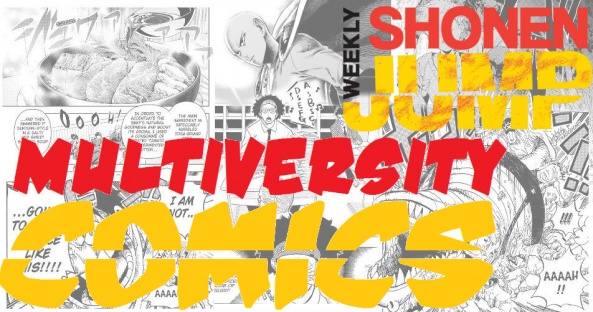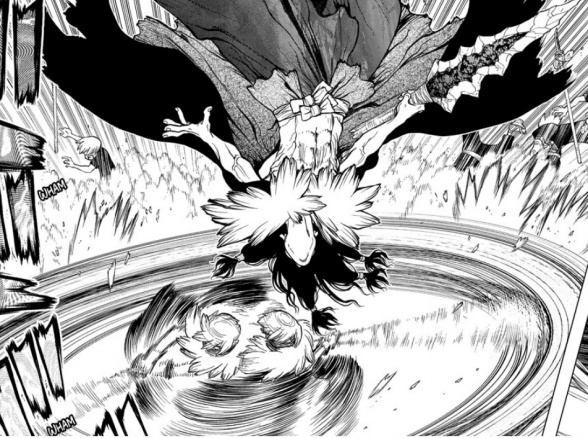
Welcome to This Week in Shonen Jump, in which a rotating duo of Multiversity staffers take a look at two stories contained in each installment of Viz Media’s Weekly Shonen Jump. For the uninitiated, Weekly Shonen Jump is an anthology that delivers more than 200 pages of manga of all varieties. We hope that you’ll join us in exploring the world of Weekly Shonen Jump each week. If you are unfamiliar, you can read sample chapters and subscribe at Viz.com.

This week, Rowan and Matt check in with “Dr. Stone” and “The Promised Neverland.” If you have any thoughts on these titles, or “My Hero Academia” “Black Clover,” “One Piece,” “Seraph at the End,” “Blue Exorcist,” “Hunter x Hunter,” “We Never Learn,” or “Food Wars,” let us know in the comments!

Dr Stone Chapter 77
Written by Riichiro Inagaki
Illustrated by Boichi
Reviewed by Rowan Grover
“Dr Stone” continues to be one of the more entertaining series of Shonen Jump as the series gets into the meat of the Stone Wars. Inagaki is handles two plot threads simultaneously and quite smoothly too. We get to see a lighter side of the story with Senku and Chrome working up some chemistry to create Dynamite, and Tsukasa squaring off with some of Senku’s gang. Both work together in a really seamless manner to create a nicely paced story, where we get high action from everytime Tsukasa is on screen, before Inagaki evens out the story with a comedic interlude from Senku and Chrome. It’s the perfect breather before you’re swept back up again in the action, and before you know it, the issue is over and you’re craving next week’s installment already.
There isn’t a lot of character development this issue aside from Senku making another fantastical scientific discovery, however. A lot of this is sacrificed in favour of moving the plot forward, thankfully, whilst providing a great fight to continue to show Tsukasa as an unstoppable force. What I love is the way that Inagaki uses previously established plot threads to bring about a revelation in this story. When Senku requires Sulfurina for his experimenting, Chrome has some handy to help, left over from the opening volley of the war’s beginning. It’s a clever setup that doesn’t feel forced or distinctly written for this moment, making the story feel like it’s naturally unfolding in Senku’s favor. Finally, Inagaki melds the two plot threads together in a satisfying way that finally feels like Senku has the other hand once more of the menacingly powerful and influential Tsukasa. It’s a solid turning point chapter that progresses the story of “Dr Stone”, without really developing characters but giving a lot of solid story moments instead.
Boichi’s artwork in this series feels like it has become a lot less sculpted than it initially appeared, with fluid action scenes and more cartoony, humanised intimate moments. The first thing we see is Senku working with Chrome, and the Senku here looks a lot smaller, and more relatable than the larger-than-life figurehead he has been in the past. Instead of standing over his experiments and making big, boisterous poses, he now appears a lot standing hunched over and conversing with his comrades seemingly without an ulterior motive. We seem to get the opposite of this with Tsukasa, showing something of a role reversal. Instead of Tsukasa coming off as the more human, more hands-on leader of the two, he now is facing away from the camera or looking down with silhouetted eyes, becoming more detached and cold looking. Boichi is drawing him much closer to a villain, showing that the lines have become less blurred now that the series has progressed and given more insight into the backstory of these characters.
The fight scenes are super kinetic and fluid in this chapter, lending a lot to the different feel in aesthetic. Instead of having copious sequential panels depicting a fight with stoic poses falling into each other, Boichi now opts for bigger, grander panels with a big usage of speed lines to convey the pace and high-octane nature of the fights taking place. It shows Tsukasa as a much more lithe and deadly character, as Boichi has him leaping around moves like a spinning spear and flipping through the air with relative ease. There is still a lot of focus on characters during these scenes, however, which cleverly gives us an insight into how these characters are reacting without relying on internal monologue. When we see the three-man maneuver take place, we see the science-team looking progressively satisfied as each person reveals themselves, while Tsukasa slowly has a feeling of dread dawn on him. It makes for a greatly paced fight that doesn’t lose out on conveying these characters’ feelings as well as action.
Continued belowThe Stone Wars continue to rumble on with some satisfying story beats in “Dr Stone” #77. Inagaki intertwines two plot threads cleverly, while Boichi brings a more fluid and kinetic style to the table. This series continues to show the rest how it’s done.
Final Score: 8.9 – “Dr Stone” continues to impress, handling multiple plot threads and delivering satisfying visual action.

The Promised Neverland Chapter 106
Written by Kaiu Shirai
Illustrated by Posuka Demizu
Reviewed by Matt Lune
Entitled ‘The Way Out,’ this latest chapter of “The Promised Neverland” tackles a couple of concepts that the escapees of Grace Field have never faced before: being confronted with a situation that they are not adequately prepared for, and the very real possibility that they’ll have to kill other humans as opposed to the demons they’ve faced up to now.
The latter concept is arguably the more fascinating for the continuing narrative of this series, because, as we’ve seen in comparable books like “The Walking Dead,” taking the decision to kill a fellow human to ensure your own survival isn’t one to be taken lightly, especially when the characters in question are children. It’s also not something you can walk back once it’s done, and while there’s no doubt that this series is unafraid to take us into such dark territory, it’s interesting how they resolve that particular conflict in this chapter.
Much like “The Walking Dead,” “The Promised Neverland” has gotten to the point where it’s becoming increasingly clear that the world outside the orphanages is not as simple as ‘man versus monster.’ It’s hard to imagine that this series will go so far as to have its own “We are the Walking Dead!” moment, but this extra level of complexity – aside from ensuring the longevity of the series – adds an extra dimension to the series that is continually unafraid to reinvent itself.
The previously mentioned concept of the characters being surprisingly unprepared for what confronts them only elevates the differences between the demons they’ve faced before and this new, all-too-human threat. Trapped in the underground tunnels of their bunker and forced to abandon their makeshift home, Emma, Ray and the other children fill the panels with genuinely defeatist thoughts. They’ve faced demons, death, and destruction at every turn, and yet now, against eight heavily armed human men, writer Kaiu Shirai fills their inner monologues with questions, doubts, and frantic thoughts.
Throughout “The Promised Neverland,” every seemingly hopeless moment is punctuated with flashbacks in which the kids explain exactly how they’ve remained one step ahead of both the demons and the reader. It’s part of the book’s charm, in fact, seeing just how smart and well prepared the heroes can be. Here though, the structure is different entirely. Yes, they have planned for a raid/escape like this, in so much as they’ve got multiple secret doors and exits. However, some fairly simple tactical awareness on the part of their attackers has scuppered their preparedness, meaning that the kids are forced to think on their feet, plan on the fly and – perhaps most importantly – utilize all of their experiences so far in order to make an escape.
This slight shift in both the structure and the narrative threat not only ratchets up the tension, but leans into the very real idea that these characters are not, and in fact, cannot be, the same people that they were at the start of the series. Shonen manga delights in showing us protagonists that grow over time, and who develop over the course of their journey, but rarely is it seen in such a subtle and earned way.
With gas masks, numerous tunnels and the dark of night providing restrictive storytelling avenues – visually speaking – artist Posuka Demizu nevertheless manages to inject excitement and variation into this chapter, in the form of dynamic angles, harsh cropping and a keen eye on panel structure. The pages where the kids are trapped in the tunnels are filled with thick panel borders, physically restricting their movement on the page, and each panel is an awkward close-up, implying cramped conditions. Contrast that with their escape at the end of the chapter, and the whole page opens up for a wide shot of the group, now finally free of their confinement. It’s not exactly subtle work, but it not only adds to the tension of the scenes but pulls us into their claustrophobic situation.
“The Promised Neverland” continues to push forward into unexpected directions, and this chapter allows the series to introduce a dark new dilemma for the group to confront. It feels as though the resolution comes a little too easy, but it’s doubtful that this will be the last time that they will have to confront the idea of turning their weapons onto another human. Similarly, their escape doesn’t carry the weight placed upon it by the hopeless and frantic narrative of the rest of the chapter, but it still leaves the characters in an interesting place moving forward.
Final Verdict: 7.7 – Some interesting concepts here that get resolved a little too easily, but overall this is a chapter that continues to prove that “The Promised Neverland” is unafraid to reinvent itself.






